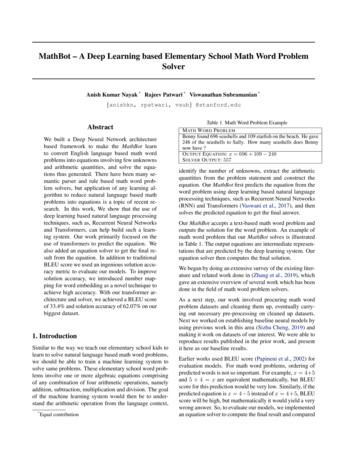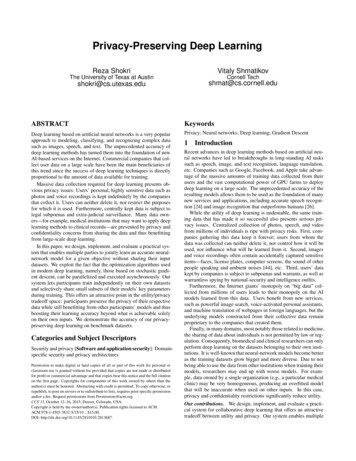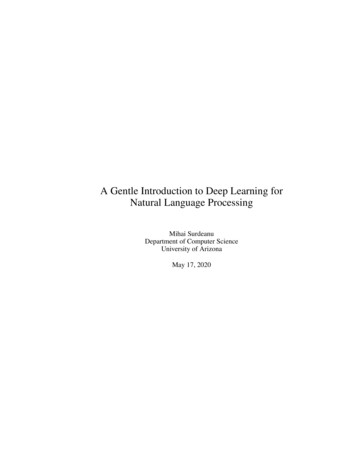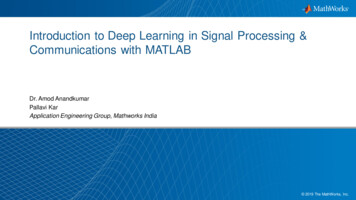
Transcription
MathBot – A Deep Learning based Elementary School Math Word ProblemSolverAnish Kumar Nayak * Rajeev Patwari * Viswanathan Subramanian *{anishkn, rpatwari, vsub} @stanford.eduAbstractWe built a Deep Neural Network architecturebased framework to make the MathBot learnto convert English language based math wordproblems into equations involving few unknownsand arithmetic quantities, and solve the equations thus generated. There have been many semantic parser and rule based math word problem solvers, but application of any learning algorithm to reduce natural language based mathproblems into equations is a topic of recent research. In this work, We show that the use ofdeep learning based natural language processingtechniques, such as, Recurrent Neural Networksand Transformers, can help build such a learning system. Our work primarily focused on theuse of transformers to predict the equation. Wealso added an equation solver to get the final result from the equation. In addition to traditionalBLEU score we used an ingenious solution accuracy metric to evaluate our models. To improvesolution accuracy, we introduced number mapping for word embedding as a novel technique toachieve high accuracy. With our transformer architecture and solver, we achieved a BLEU scoreof 33.4% and solution accuracy of 62.07% on ourbiggest dataset.1. IntroductionSimilar to the way we teach our elementary school kids tolearn to solve natural language based math word problems,we should be able to train a machine learning system tosolve same problems. These elementary school word problems involve one or more algebraic equations comprisingof any combination of four arithmetic operations, namelyaddition, subtraction, multiplication and division. The goalof the machine learning system would then be to understand the arithmetic operation from the language context,*Equal contributionTable 1. Math Word Problem ExampleM ATH W ORD P ROBLEMBenny found 696 seashells and 109 starfish on the beach. He gave248 of the seashells to Sally. How many seashells does Bennynow have ?O UTPUT E QUATION: x 696 109 248S OLVER O UTPUT: 557identify the number of unknowns, extract the arithmeticquantities from the problem statement and construct theequation. Our MathBot first predicts the equation from theword problem using deep learning based natural languageprocessing techniques, such as Recurrent Neural Networks(RNN) and Transformers (Vaswani et al., 2017), and thensolves the predicted equation to get the final answer.Our MathBot accepts a text-based math word problem andoutputs the solution for the word problem. An example ofmath word problem that our MathBot solves is illustratedin Table 1. The output equations are intermediate representations that are predicted by the deep learning system. Ourequation solver then computes the final solution.We began by doing an extensive survey of the existing literature and related work done in (Zhang et al., 2019), whichgave an extensive overview of several work which has beendone in the field of math word problem solvers.As a next step, our work involved procuring math wordproblem datasets and cleaning them up, eventually carrying out necessary pre-processing on cleaned up datasets.Next we worked on establishing baseline neural models byusing previous work in this area (Sizhu Cheng, 2019) andmaking it work on datasets of our interest. We were able toreproduce results published in the prior work, and presentit here as our baseline results.Earlier works used BLEU score (Papineni et al., 2002) forevaluation models. For math word problems, ordering ofpredicted words is not so important. For example, x 4 5and 5 4 x are equivalent mathematically, but BLEUscore for this prediction would be very low. Similarly, if thepredicted equation is x 4 5 instead of x 4 5, BLEUscore will be high, but mathematically it would yield a verywrong answer. So, to evaluate our models, we implementedan equation solver to compute the final result and compared
MathBot – A Deep Learning based Elementary School Math Word Problem Solverit with the expected result.We explored several transformer architectures to improveour model accuracy. For transformers, we varied the number of layers, embedding size, hidden size and attentionheads. We ran hyperparameter tuning experimenets to findthe right size transformer for our use case, and also tunedlearning rate, dropout and batch size hyperparameters.We got very good results with our elementary dataset.However, when we ran our best models on bigger datasetsthe solution accuracy was low. When we did error analysis, we found out for larger datasets the model had difficultyunderstanding new numbers it hadn’t seen before. In orderto overcome this limitation, we came up with number mapping for word embedding technique. This novel techniqueallowed us to achieve higher solution accuracy. Figure 1shows the modified math word problem. We first extractthe numbers and replace them with n# numbers. We provide the number mapping to our solver to solve the equation.Figure 1. Math Word Problem Example with Number Mappingfor Word Embedding2. Related WorkThe work done by (Wang et al., 2017), and recently by(Sizhu Cheng, 2019) is of particular interest to our approach to using deep neural networks in solving mathword problems. We delved deeper on work done by(Sizhu Cheng, 2019), using it as guidance for baseline forour project.3. DatasetThere are a few datasets available for the algebraic problemsolving that have been used for both, rule-based solvers aswell as Machine Learning based solvers. that were used inthe published literature. They are listed in the table (?).Dolphin18k and MAWPS datasets comprise of both elementary and complex algebraic problems while Alg514,Draw-1k is an elementary problem dataset in its entirety.3.1. Pre-processingThis Dolphin18k dataset was built using the scripts andtools provided by the authors. The scripts collect the datafrom Yahoo Answers. Data clean up was performed asper the authors’s instructions. The train and dev test splitsare also provided by the scripts. The cleaned up dataset isavailable in a json format. Alg514, Draw-1k and MaWPSare readily available as json files and no webscraping isnecessary to build them.Our models, both Bi-LSTIM-Attn and Transformer bothrequire input source file and target file. So, for each example entry, ”text” section from json files is written to .txt and”equation” section is written to .txt. Further more, each entry in source and target is converted to lower case to avoidemphasis on uppercase letters in the dataset.The inspiration for creating MathBot came from observing parents of elementary school kids spending significanttime every day to check their kids’ homework and tests. Wethought that MathBot will be of immense help to the parents, if it can scan the kids’ word problem and output anequation and final solution.A subset of examples were extracted from all the datasets,that contain a single unknown. This was achieved by writing a script that parses the equations entry of the json file,search for number of unknowns and equations, extract onlythe examples that contain a single unknown.Further, as mentioned by (Zhang et al., 2019), designingan automatic solver for mathematical word problems hasa long history dating back to the 1960s (Bobrow, 1964),(Feigenbaum et al., 1963), (Charniak, 1969). The problem is particularly challenging because there remains awide semantic gap to parse the human-readable words intomachine-understandable logic so as to facilitate quantitative reasoning. Hence, math word problem solvers arebroadly considered as good test beds to evaluate the intelligence level of agents in terms of natural language understanding (Clark, 2015), (Clark & Etzioni, 2016) and thesuccessful solving of math word problem solvers wouldconstitute a milestone towards general artificial intelligence.3.2. Train-Dev SplitsThe final goal of our Deep Learning model is to understand and solve elementary math word problems. In order to achieve this, the train/dev set distributions have tobe clearly distinguished. The train set can comprise of elementary as well as complex problems but the dev set canonly contain elementary problems. The final combinationsof datasets that we used for our Deep Learning based elementary math word problem solver described in the tablebelow.
MathBot – A Deep Learning based Elementary School Math Word Problem SolverDATASETC OUNTTable 2. Dataset SourcesD ESCRIPTIONR EFERENCED OLPHIN - 18,46018 KA LG 514514MAWPS 3,065Dolphin18K is a dataset created for math word problem solving, containing 18,460 problemsposted by users on the community question answering site, Yahoo! Answers.514 elementary algebraic problems used in referred literatureMAWPS dataset, also used in (Sizhu Cheng, 2019)D RAW1KDiverse Algebra Word (DRAW-1K), consists of 1000 word problems crawled from algebra.com1,000Table 3. Math Word Problem Example with Number Mapping forWord EmbeddingM ODIFIED M ATH W ORD P ROBLEMBenny found 696 seashells and 109 starfish on the beach. He gave248 of the seashells to Sally. How many seashells does Bennynow have ?N UMBER M APPING: n0 696; n1 109; n2 248O UTPUT E QUATION: x n0 n1 n2MathBot 568(Huang et al.,2016)(Alg)(Kushmanet al., 2014)(Kushmanet al., 2014)5. Methods5.1. Baseline Learning ModelsFor establishing our baseline model, we reproduced the results presented in (Sizhu Cheng, 2019) for Neural Machine Translation with RNNs.Dev100100250250100010004. Number Mapping for Word EmbeddingAfter exploring performance in both Bi-LSTM-Attn 5.1.1and Transformer 5.2 models and performing error analysis,we discovered that the model would emphasize on the constant values in the problem statement. For example, consider the following scenario: ”Benny found 696 seashellsand 109 starfish on the beach. He gave 248 of the seashellsto Sally. How many seashells does Benny now have ?” Inthis example, the numbers 696, 109 and and 248 becomea part of vocabulary and the model cannot generalize wellenough. After some initial thoughts we came up with anidea to map the constants to variables in order to help themodel generalize the problem better, without emphasizingon any particular constants. We then did a literature surveyand came across (Wang et al., 2018), which reinforced ouridea.To achieve number mapping, we wrote a parser in Pythonthat would parse equation of every example, convert constants into variables, generate a translation file and replacethe constants in input text to mapped variable. The scriptreplaces first constant with n0, second with n1 and so on.Table 3 shows the intermediate mapping results. The mapping information is provided as input to the equation solver.With these changes, the model learns to generalize the target better as numbers now maps to a smaller set of quantities, i.e. instead of number representations, to mapped n#representations (# 0,1,2.).Figure 2. Baseline architecture5.1.1. N EURAL M ACHINE T RANSLATION W ITH RNNFigure 2 shows the baseline RNN architecture. BaselineRNN model model uses a Bidirectional LSTM Encoder anda Unidirectional LSTM Decoder. This Seq2Seq Model hasmultiplicative attention, as shown on the third step of thedecoder. The baseline RNN produces a probability distribution Pt over target words at the tth timestep. Here, Vtis the size of the target vocabulary. Loss function is shownbelow as well. Here, θ represents all the parameters of themodel and Jt (θ) is the loss on step t of the decoder. gt isthe 1-hot vector of the target word at timestep t.Pt Sof tmax(Wvocab ot ), where Pt Vt 1 , Wvocab Vt hJ(θ) CE(Pt , gt )5.1.2. BASELINE S ETUPTo get the baseline RNN model to run, we setup a pythonconda environment to run neural machine translation codethat came with (cs2). We modified the code base to suit ourneeds. In our case, the math question dataset was the sourcelanguage and the equations were the target language. Wehad to change how the equations were preprocessed, as the
MathBot – A Deep Learning based Elementary School Math Word Problem SolverTable 4. Baseline BLEU scores (* Embed Size, Hidden Size,Dropout)HYPERPARAMETERS 32, 128, 0.532, 512, 0.532, 512, 0.332, 1024, 0.3256, 256, 0.3M AWP S -F ULL34.2586.8688.3888.8991.93M AWP S -E LEM27.3889.8188.9288.8844.23equations had various symbols for the arithmetic operators and parentheses. We established the baseline with theMAWPS dataset. Table 5.1.2 shows the baselines scores forthe RNN bi-LSTM, LSTM Attention Model architecture.5.2. TransformerTransformer architecture was presented in (Sizhu Cheng,2019) as well. However, we weren’t able to reproducethe transformer results as we didn’t have access to thedataset that was used to report results. Instead, we created our baseline Transformer by downloading the Transformer model for language understanding notebook from(tft), which implements the transformer model presented in(Vaswani et al., 2017). We list below the important functions from the (Vaswani et al., 2017).Figure 3. Transformer Framework. Figure reproduces the transformer model from (Vaswani et al., 2017).Attention FunctionQK TAttention(Q, K, V ) Softmax( )VdkMultiHead(Q, K, V ) Concat(head1 , ., headh )W Owhere, headi Attention(QWiQ , KWiK , V WiV )Figure 3 shows the Transformer Framework. It uses thetransformer model to predict equations, and includes thesolver to solve equations. In the next section, we discussthe architecture exploration and hyperparameter tuning results.5.2.1. BASELINE S ETUPThe transformer notebook only has the model implementation. In order to evaluate various transformer architectures,we added tensorboard logging. Figure 4 shows the loss andaccuracy for the baseline transformer configuration. Thebaseline transformer we chose had number of layers as 4,dimensionality of input and output (Embed Size) as 128;inner layer dimensionality (Hidden Size) as 512, and number of heads as 8.6. Experiments6.1. Evaluation MetricsFor evaluating the various transformer architectures, weused BLEU score and solution accuracy. We looked at e 4. Loss and Accuracy obtained using Tensorboard for theCombined dataset with two different transformer configurationsgram, where n 1.4, BLEU scores, as well as the cumulative score of 1.4 n-grams. We also considered solutionaccuracy as an evaluation metric. In the case of solutionaccuracy, the score for an example is either 1 or 0.The loss function we used is SparseCategoricalCrossentropy from Tensorflow Keras implementation. We alsoused SparseCategoricalAccuracy from Tensorflow Kerasfor analysis the accuracy every steip of the model. We alsoimplemented our Equation Solver to compute solution accuracy.6.2. Hyperparameter TuningTable 5 shows the range of values for the hyperparameterswe explored. For the transformer architecture, we changedthe number of layers, embed size, hidden size and the number of attention heads. For improving model accuracy,we explored various settings for learning rate, dropout andbatch size. Figure 6 shows a sample of how the hyperpa-
MathBot – A Deep Learning based Elementary School Math Word Problem Solverarchitectures required bigger GPU machines and longerhours to train. Our fine tuning runs took several days onmultiple machines. The biggest models we training hadapproximately 13 million parameters.Our Ext-Elem dataset achieves a very high accuracy of 84%after we did the number mapping. The combined datasetachieved an accuracy of 62%. Our number mapping forword embedding helped both datasets, but it did exceptionally well on the Combined dataset. One of the reasonsfor could be that the combined dataset had examples formDolphin-18K, and many of the questions in that datasetweren’t very well written.Figure 5. Hyper ParameterDropoutBatch SizeFigure 7. Results for different datasetsLearning RateTransformer ArchitecturesFigure 6. Hyperparameter Tuning Resultsrameter tuning performed on our Ext-Elem dataset. We ransimilar tuning for all our datasets, and different datasetsperformed well with different settings for transformer architecture, learning rate, dropout and batch size. We foundthe best setting for each of the dataset. We found thatsmaller values for learning rate, batch size and dropout didwell for the smaller datasets. For bigger datasets and biggertransformers, higher dropouts and batch sizes worked better. We faced capacity issues on GPUs when doing largetraining runs.6.3. Error AnalysisWe analyzed the results from Ext-Elem and Combineddatasets. One of the things we noticed is that the model wasnot generalizing to new numbers found in the word problems. We implemented the number mapping for word embedding to overcome this limitation. We also improved onour data pre-processing, which corrected and/or removedmalformed questions and equations.6.4. Discussion and ResultsFigure 7 shows the results for our four datasets. The datawe present are from the fine tuned models we obtained foreach of the datasets. We trained our model on AWS EC2instance, NVIDIA V100, P100 and GTX 1070 GPUs thatwere available to us. The bigger datasets and transformer7. Conclusion and Future WorkWe reproduced Bi-LSTM, LSTM Attn Model based workfrom (Sizhu Cheng, 2019) for our initial setup. We analyzed BLEU scores and predicted equations to concludethat BLEU score alone is not sufficient evaluation metrics.We developed our equation solver, and used it to computesolution accuracy scores. Further error analysis on baseline transformer results helped us to develop number mapping technique. Using number mapping for word embedding, we obtained much improved results. Dataset withelementary problems in general gave better results sincethey were cleaner. Combined dataset didn’t perform aswell, since several examples had inconsistencies in problems and equations especially in Dolphin18k dataset. Wetuned transformer with number mapping for word embedding, and equation solver accuracy metrics resulted in improved prediction.As part of future work, we plan to implement beam searchfor transformer model to improve prediction quality. Wealso would like to try larger AQUA-RAT (aqu) datasetto extract equations, and obtain results. We plan to usetransformer-XL (Dai et al., 2019) and BERT (Devlin et al.,2018), (Song et al., 2019) like pre-training to get bettermodels. We would like to do further research on howto generalize to entirely new problem sets. Our eventualgoal is to build an end-to-end application, that can scana textbook problem (printed or hand-written), convert thescanned image into text, understand the text as a math wordproblem and output its solution.
MathBot – A Deep Learning based Elementary School Math Word Problem SolverAcknowledgementsWe’d like to show our gratitude towards CS230 courseteaching staff in general for helping us with queries relatedto Deep Learning that helped us develop strong understanding of the subject which we could apply in this project. Further, we’re immensely grateful to teaching assisstant Advay Pal who guided us at each step of the project work.Without his constant support and advice, this project wouldnot have been possible.ContributionsAll the team members have contributed equally to thisproject through very strong collaboration. We had all discussions and brainstorming sessions together. We dividedthe work amongst ourselves for the research and development to go in parallel as much as possible. All of us workedin some capacity on all the pieces.ReferencesDiverse algebra word problem dataset with derivation annotations. URL spx?id 52628.fixed-length context. CoRR, abs/1901.02860, 2019.URL http://arxiv.org/abs/1901.02860.Devlin, Jacob, Chang, Ming-Wei, Lee, Kenton, andToutanova, Kristina. BERT: pre-training of deep bidirectional transformers for language understanding. 2018.URL http://arxiv.org/abs/1810.04805.Feigenbaum, Edward A, Feldman, Julian, et al. Computersand thought. New York McGraw-Hill, 1963.Huang, Danqing, Shi, Shuming, Lin, Chin-Yew, Yin, Jian,and Ma, Wei-Ying. How well do computers solve mathword problems? large-scale dataset construction andevaluation. In Proceedings of the 54nd Annual Meeting of the Association for Computational Linguistics, pp.887–896, 2016.Kushman, Nate, Artzi, Yoav, Zettlemoyer, Luke, and Barzilay, Regina. Learning to automatically solve algebraword problems. In Proceedings of the 52nd AnnualMeeting of the Association for Computational Linguistics (Volume 1: Long Papers), pp. 271–281, 2014.Papineni, Kishore, Roukos, Salim, Ward, Todd, and Zhu,Wei-Jing. Bleu: A method for automatic evaluation ofmachine translation. In Proceedings of the 40th AnnualMeeting on Association for Computational Linguistics,pp. 311–318, 2002.Aqua-rat (algebra question answering with rationales).URLhttps://deepmind.Peters, Matthew E, Neumann, Mark, Iyyer, Mohit, Gardcom/research/open-source/ner, Matt, Clark, Christopher, Lee, Kenton, and ionales.moyer, Luke. Deep contextualized word representations.Cs224n, assigment #4. URL http://web.stanford.arXiv preprint arXiv:1802.05365, 2018.edu/class/cs224n/assignments/a4.pdf.Shi, Shuming, Wang, Yuehui, Lin, Chin-Yew, Liu, XiTransformer model for language understanding. URLaojiang, and Rui, Yong. Automatically solving numhttps://www.tensorflow.org/tutorials/ber word problems by semantic parsing and reasontext/transformer.ing. In Proceedings of the 2015 Conference on Empirical Methods in Natural Language Processing, pp.Bobrow, Daniel G. Natural language input for a computer1132–1142, Lisbon, Portugal, September 2015. Assoproblem solving system. 1964.ciation for Computational Linguistics. doi: 10.18653/v1/D15-1135. URL https://www.aclweb.org/Charniak, Eugene. Computer solution of calculus wordanthology/D15-1135.problems. In Proceedings of the 1st international jointconference on Artificial intelligence, pp. 303–316. MorSizhu Cheng, Nicolas Chung. Simple mathematical wordgan Kaufmann Publishers Inc., 1969.problems solving with deep learning. 2019.Clark, Peter. Elementary school science and math tests asa driver for ai: take the aristo challenge! In TwentySeventh IAAI Conference, 2015.Clark, Peter and Etzioni, Oren. My computer is an honorstudent—but how intelligent is it? standardized tests asa measure of ai. AI Magazine, 37(1):5–12, 2016.Dai, Zihang, Yang, Zhilin, Yang, Yiming, Carbonell,Jaime G., Le, Quoc V., and Salakhutdinov, Ruslan.Transformer-xl: Attentive language models beyond aSong, Kaitao, Tan, Xu, Qin, Tao, Lu, Jianfeng, andLiu, Tie-Yan.MASS: masked sequence to sequence pre-training for language generation. CoRR,abs/1905.02450, 2019. URL http://arxiv.org/abs/1905.02450.Vaswani, Ashish, Shazeer, Noam, Parmar, Niki, Uszkoreit,Jakob, Jones, Llion, Gomez, Aidan N, Kaiser, Ł ukasz,and Polosukhin, Illia. Attention is all you need. In Advances in Neural Information Processing Systems 30, pp.5998–6008, 2017.
MathBot – A Deep Learning based Elementary School Math Word Problem SolverWang, Lei, Wang, Yan, Cai, Deng, Zhang, Dongxiang, andLiu, Xiaojiang. Translating a math word problem to anexpression tree. 2018. URL http://arxiv.org/abs/1811.05632.Wang, Yan, Liu, Xiaojiang, and Shi, Shuming. Deep neural solver for math word problems. In Proceedings ofthe 2017 Conference on Empirical Methods in NaturalLanguage Processing, pp. 845–854, 2017.Zhang, Dongxiang, Wang, Lei, Zhang, Luming, Dai,Bing Tian, and Shen, Heng Tao. The gap of semantic parsing: A survey on automatic math word problemsolvers. IEEE transactions on pattern analysis and machine intelligence, 2019.
MathBot - A Deep Learning based Elementary School Math Word Problem Solver Table 2. Dataset Sources DATASET COUNT DESCRIPTION REFERENCE DOLPHIN-18K 18,460 Dolphin18K is a dataset created for math word problem solving, containing 18,460 problems posted by users on the community question answering site, Yahoo! Answers. (Huang et al., 2016)










